Project Communication Plan Development
VerifiedAdded on 2020/05/16
|9
|1765
|198
AI Summary
This assignment focuses on developing a comprehensive communication plan for a project. It identifies key stakeholders, including customers and suppliers, and outlines their communication needs. The plan emphasizes the roles of the initiator and recipient in ensuring effective communication throughout the project lifecycle. A final communication plan is presented, incorporating weekly meetings for team updates and highlighting the rationale behind its development.
Contribute Materials
Your contribution can guide someone’s learning journey. Share your
documents today.
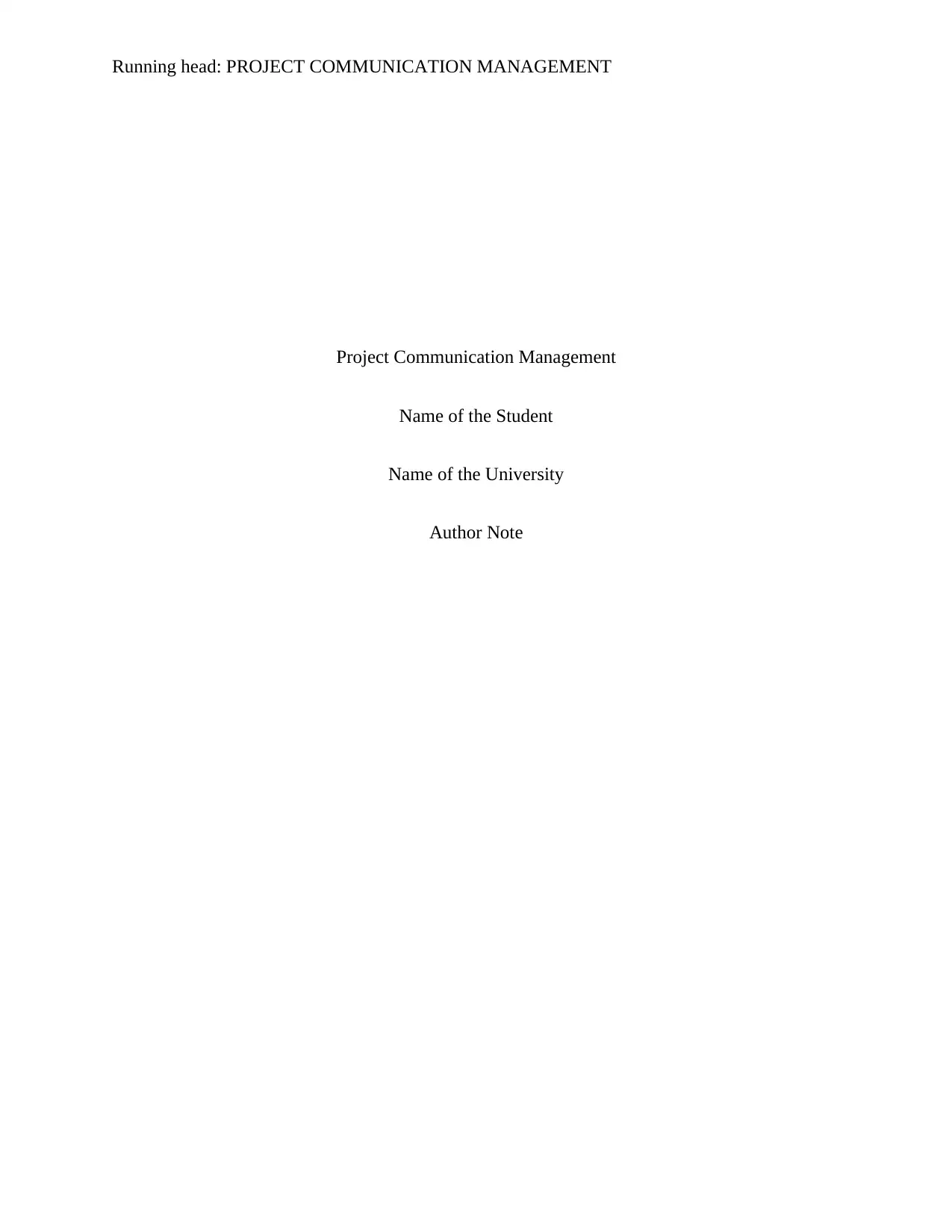
Running head: PROJECT COMMUNICATION MANAGEMENT
Project Communication Management
Name of the Student
Name of the University
Author Note
Project Communication Management
Name of the Student
Name of the University
Author Note
Secure Best Marks with AI Grader
Need help grading? Try our AI Grader for instant feedback on your assignments.
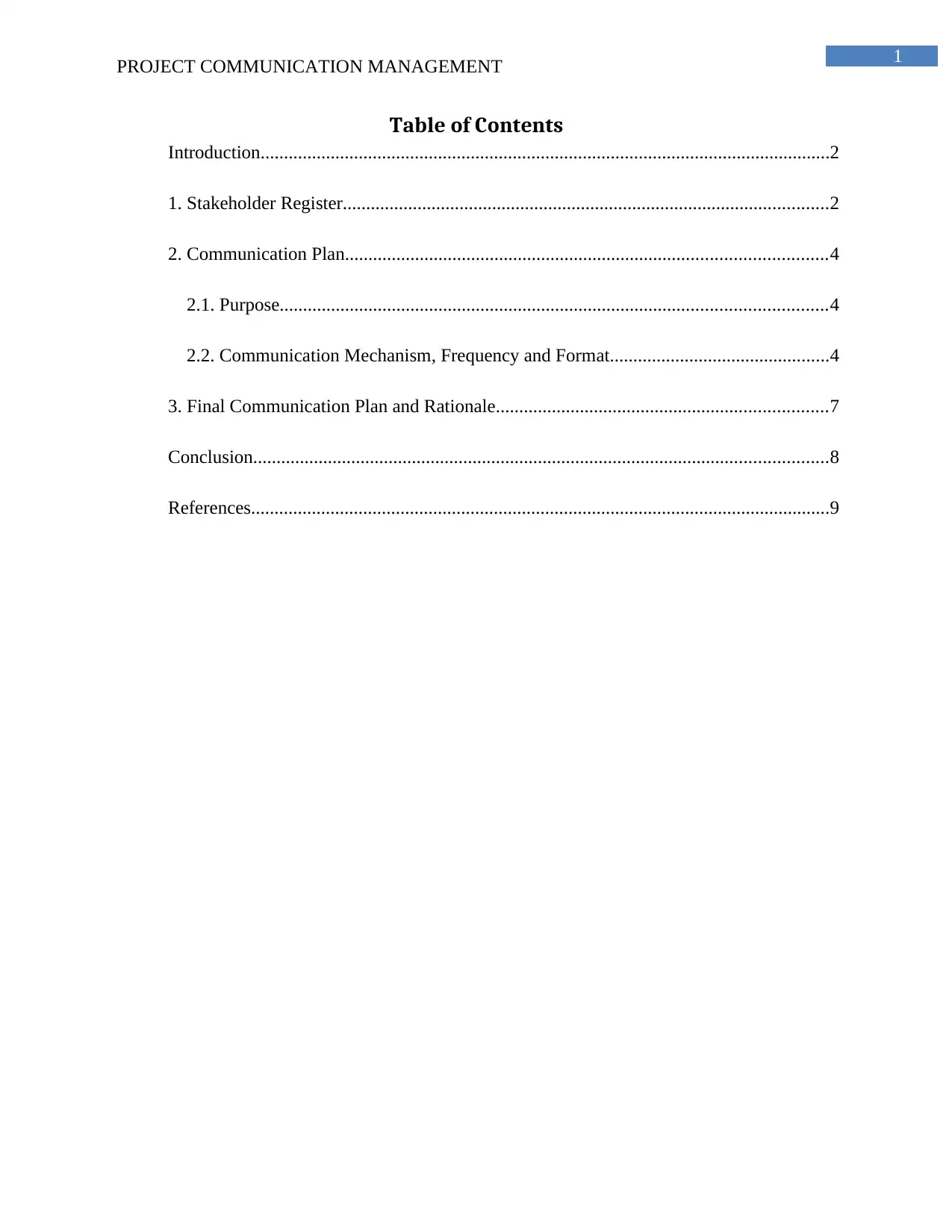
1
PROJECT COMMUNICATION MANAGEMENT
Table of Contents
Introduction..........................................................................................................................2
1. Stakeholder Register........................................................................................................2
2. Communication Plan.......................................................................................................4
2.1. Purpose.....................................................................................................................4
2.2. Communication Mechanism, Frequency and Format...............................................4
3. Final Communication Plan and Rationale.......................................................................7
Conclusion...........................................................................................................................8
References............................................................................................................................9
PROJECT COMMUNICATION MANAGEMENT
Table of Contents
Introduction..........................................................................................................................2
1. Stakeholder Register........................................................................................................2
2. Communication Plan.......................................................................................................4
2.1. Purpose.....................................................................................................................4
2.2. Communication Mechanism, Frequency and Format...............................................4
3. Final Communication Plan and Rationale.......................................................................7
Conclusion...........................................................................................................................8
References............................................................................................................................9
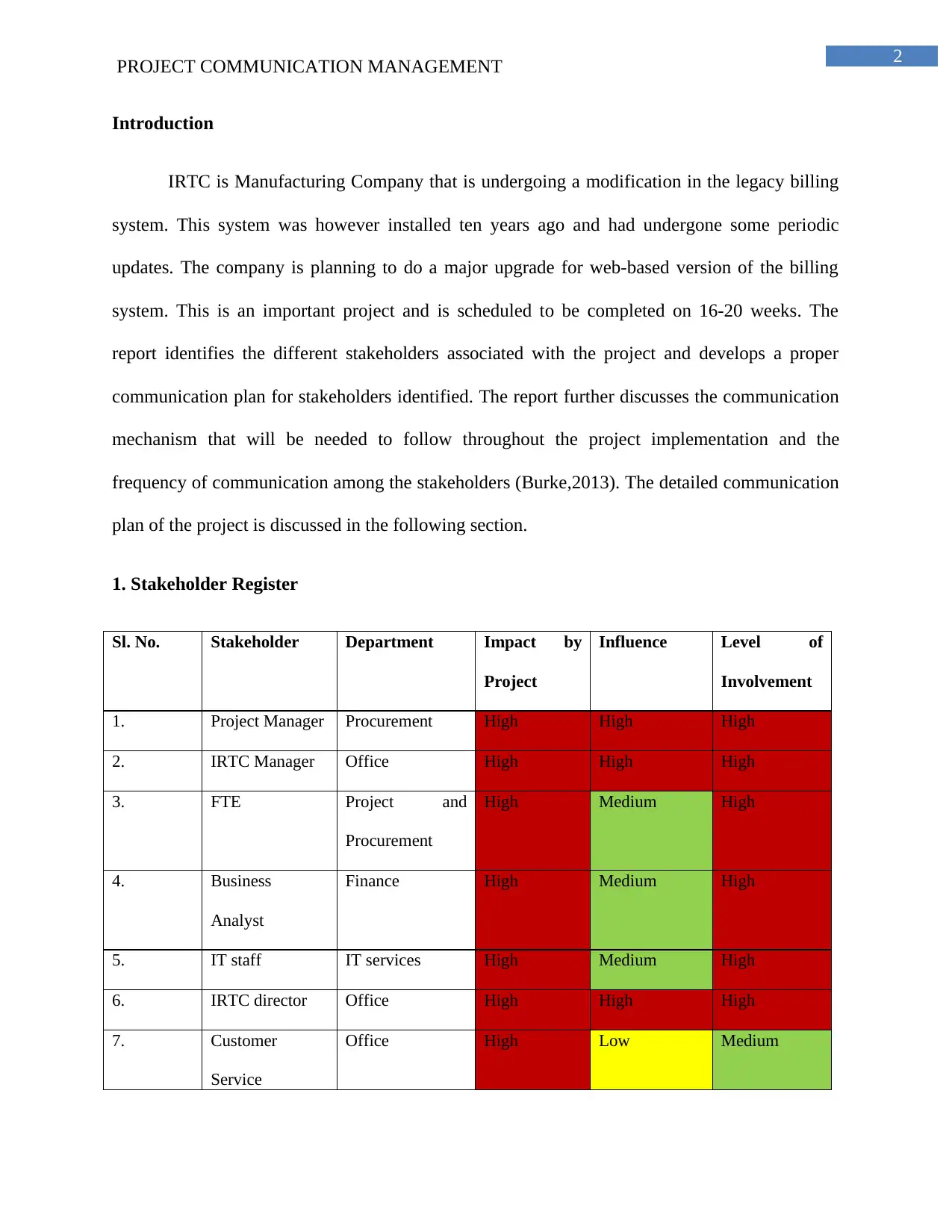
2
PROJECT COMMUNICATION MANAGEMENT
Introduction
IRTC is Manufacturing Company that is undergoing a modification in the legacy billing
system. This system was however installed ten years ago and had undergone some periodic
updates. The company is planning to do a major upgrade for web-based version of the billing
system. This is an important project and is scheduled to be completed on 16-20 weeks. The
report identifies the different stakeholders associated with the project and develops a proper
communication plan for stakeholders identified. The report further discusses the communication
mechanism that will be needed to follow throughout the project implementation and the
frequency of communication among the stakeholders (Burke,2013). The detailed communication
plan of the project is discussed in the following section.
1. Stakeholder Register
Sl. No. Stakeholder Department Impact by
Project
Influence Level of
Involvement
1. Project Manager Procurement High High High
2. IRTC Manager Office High High High
3. FTE Project and
Procurement
High Medium High
4. Business
Analyst
Finance High Medium High
5. IT staff IT services High Medium High
6. IRTC director Office High High High
7. Customer
Service
Office High Low Medium
PROJECT COMMUNICATION MANAGEMENT
Introduction
IRTC is Manufacturing Company that is undergoing a modification in the legacy billing
system. This system was however installed ten years ago and had undergone some periodic
updates. The company is planning to do a major upgrade for web-based version of the billing
system. This is an important project and is scheduled to be completed on 16-20 weeks. The
report identifies the different stakeholders associated with the project and develops a proper
communication plan for stakeholders identified. The report further discusses the communication
mechanism that will be needed to follow throughout the project implementation and the
frequency of communication among the stakeholders (Burke,2013). The detailed communication
plan of the project is discussed in the following section.
1. Stakeholder Register
Sl. No. Stakeholder Department Impact by
Project
Influence Level of
Involvement
1. Project Manager Procurement High High High
2. IRTC Manager Office High High High
3. FTE Project and
Procurement
High Medium High
4. Business
Analyst
Finance High Medium High
5. IT staff IT services High Medium High
6. IRTC director Office High High High
7. Customer
Service
Office High Low Medium
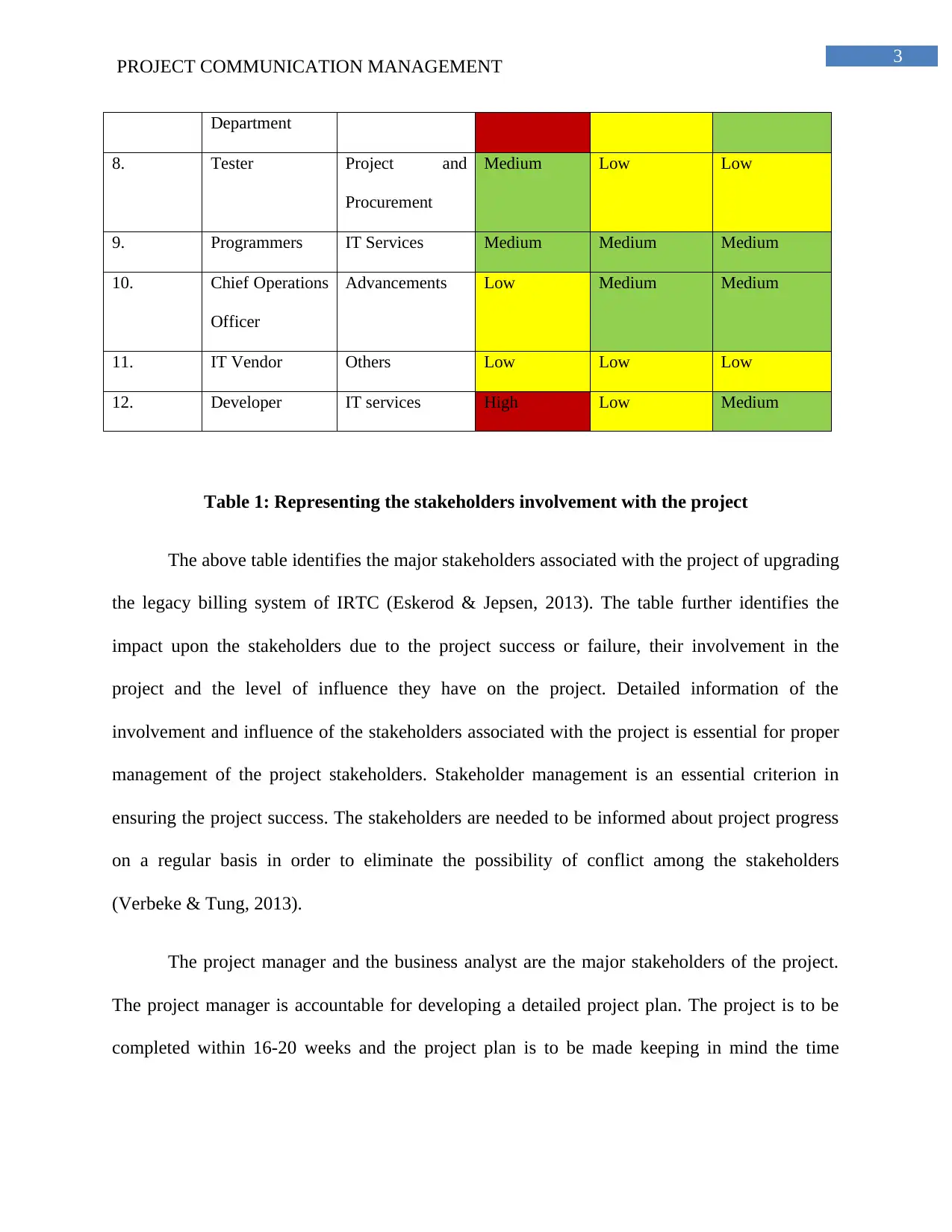
3
PROJECT COMMUNICATION MANAGEMENT
Department
8. Tester Project and
Procurement
Medium Low Low
9. Programmers IT Services Medium Medium Medium
10. Chief Operations
Officer
Advancements Low Medium Medium
11. IT Vendor Others Low Low Low
12. Developer IT services High Low Medium
Table 1: Representing the stakeholders involvement with the project
The above table identifies the major stakeholders associated with the project of upgrading
the legacy billing system of IRTC (Eskerod & Jepsen, 2013). The table further identifies the
impact upon the stakeholders due to the project success or failure, their involvement in the
project and the level of influence they have on the project. Detailed information of the
involvement and influence of the stakeholders associated with the project is essential for proper
management of the project stakeholders. Stakeholder management is an essential criterion in
ensuring the project success. The stakeholders are needed to be informed about project progress
on a regular basis in order to eliminate the possibility of conflict among the stakeholders
(Verbeke & Tung, 2013).
The project manager and the business analyst are the major stakeholders of the project.
The project manager is accountable for developing a detailed project plan. The project is to be
completed within 16-20 weeks and the project plan is to be made keeping in mind the time
PROJECT COMMUNICATION MANAGEMENT
Department
8. Tester Project and
Procurement
Medium Low Low
9. Programmers IT Services Medium Medium Medium
10. Chief Operations
Officer
Advancements Low Medium Medium
11. IT Vendor Others Low Low Low
12. Developer IT services High Low Medium
Table 1: Representing the stakeholders involvement with the project
The above table identifies the major stakeholders associated with the project of upgrading
the legacy billing system of IRTC (Eskerod & Jepsen, 2013). The table further identifies the
impact upon the stakeholders due to the project success or failure, their involvement in the
project and the level of influence they have on the project. Detailed information of the
involvement and influence of the stakeholders associated with the project is essential for proper
management of the project stakeholders. Stakeholder management is an essential criterion in
ensuring the project success. The stakeholders are needed to be informed about project progress
on a regular basis in order to eliminate the possibility of conflict among the stakeholders
(Verbeke & Tung, 2013).
The project manager and the business analyst are the major stakeholders of the project.
The project manager is accountable for developing a detailed project plan. The project is to be
completed within 16-20 weeks and the project plan is to be made keeping in mind the time
Secure Best Marks with AI Grader
Need help grading? Try our AI Grader for instant feedback on your assignments.
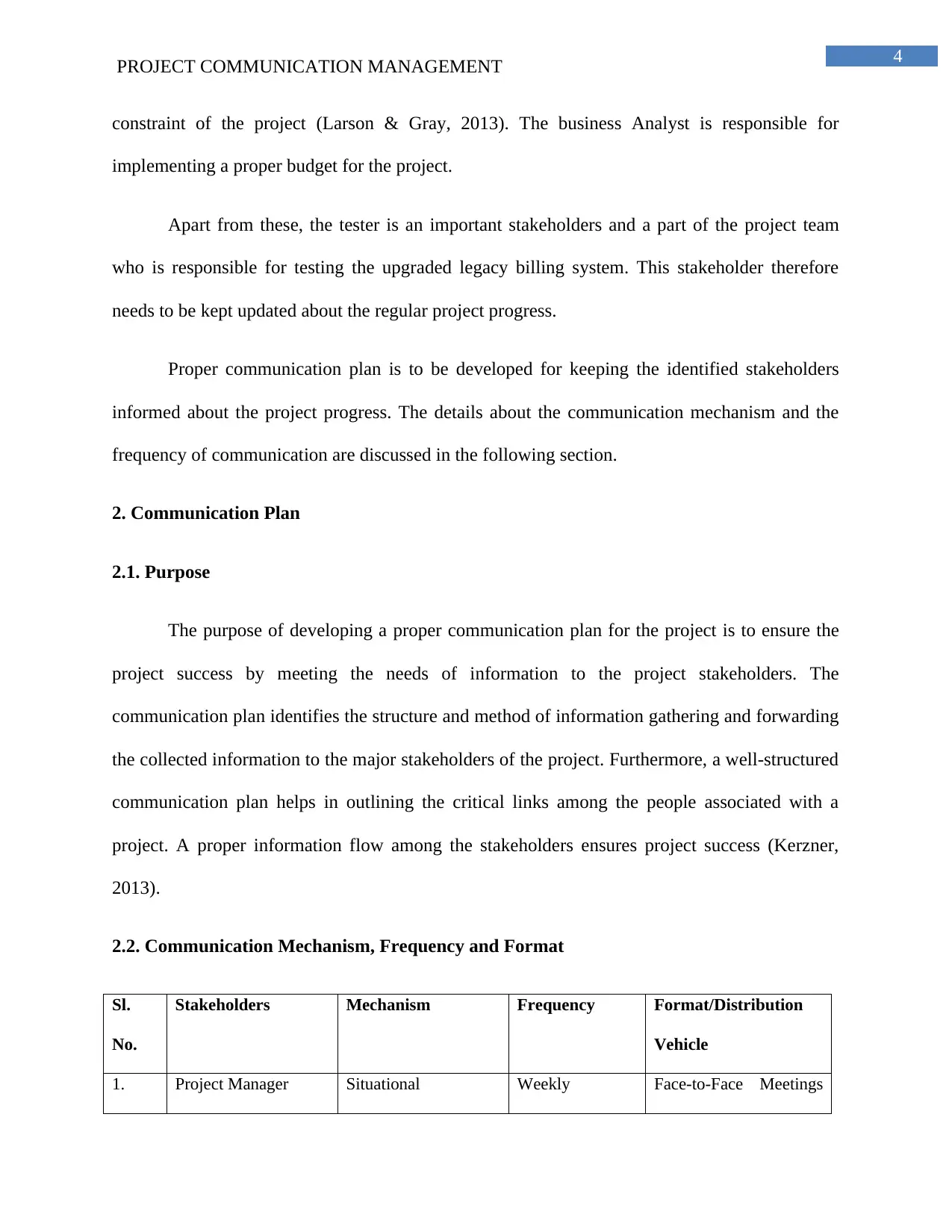
4
PROJECT COMMUNICATION MANAGEMENT
constraint of the project (Larson & Gray, 2013). The business Analyst is responsible for
implementing a proper budget for the project.
Apart from these, the tester is an important stakeholders and a part of the project team
who is responsible for testing the upgraded legacy billing system. This stakeholder therefore
needs to be kept updated about the regular project progress.
Proper communication plan is to be developed for keeping the identified stakeholders
informed about the project progress. The details about the communication mechanism and the
frequency of communication are discussed in the following section.
2. Communication Plan
2.1. Purpose
The purpose of developing a proper communication plan for the project is to ensure the
project success by meeting the needs of information to the project stakeholders. The
communication plan identifies the structure and method of information gathering and forwarding
the collected information to the major stakeholders of the project. Furthermore, a well-structured
communication plan helps in outlining the critical links among the people associated with a
project. A proper information flow among the stakeholders ensures project success (Kerzner,
2013).
2.2. Communication Mechanism, Frequency and Format
Sl.
No.
Stakeholders Mechanism Frequency Format/Distribution
Vehicle
1. Project Manager Situational Weekly Face-to-Face Meetings
PROJECT COMMUNICATION MANAGEMENT
constraint of the project (Larson & Gray, 2013). The business Analyst is responsible for
implementing a proper budget for the project.
Apart from these, the tester is an important stakeholders and a part of the project team
who is responsible for testing the upgraded legacy billing system. This stakeholder therefore
needs to be kept updated about the regular project progress.
Proper communication plan is to be developed for keeping the identified stakeholders
informed about the project progress. The details about the communication mechanism and the
frequency of communication are discussed in the following section.
2. Communication Plan
2.1. Purpose
The purpose of developing a proper communication plan for the project is to ensure the
project success by meeting the needs of information to the project stakeholders. The
communication plan identifies the structure and method of information gathering and forwarding
the collected information to the major stakeholders of the project. Furthermore, a well-structured
communication plan helps in outlining the critical links among the people associated with a
project. A proper information flow among the stakeholders ensures project success (Kerzner,
2013).
2.2. Communication Mechanism, Frequency and Format
Sl.
No.
Stakeholders Mechanism Frequency Format/Distribution
Vehicle
1. Project Manager Situational Weekly Face-to-Face Meetings
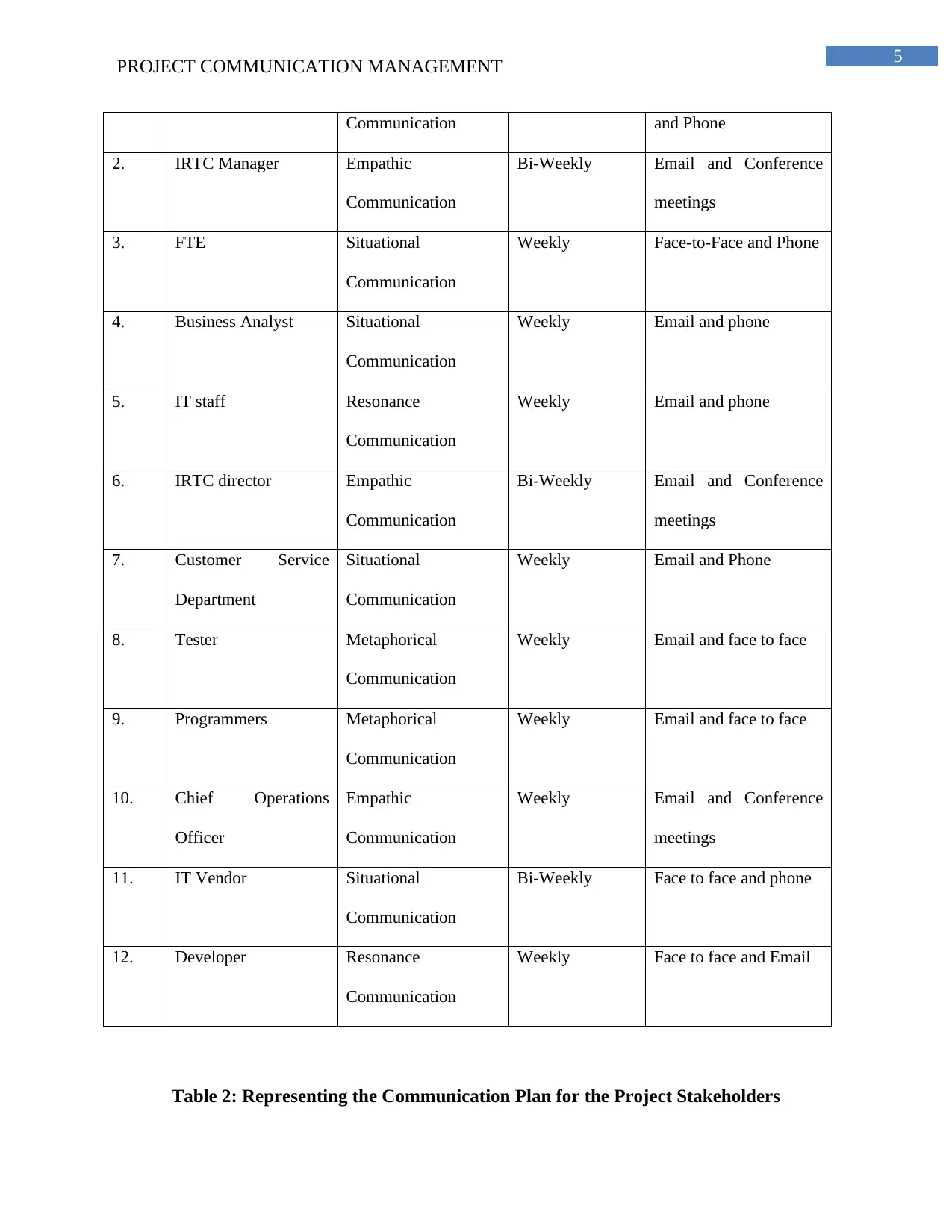
5
PROJECT COMMUNICATION MANAGEMENT
Communication and Phone
2. IRTC Manager Empathic
Communication
Bi-Weekly Email and Conference
meetings
3. FTE Situational
Communication
Weekly Face-to-Face and Phone
4. Business Analyst Situational
Communication
Weekly Email and phone
5. IT staff Resonance
Communication
Weekly Email and phone
6. IRTC director Empathic
Communication
Bi-Weekly Email and Conference
meetings
7. Customer Service
Department
Situational
Communication
Weekly Email and Phone
8. Tester Metaphorical
Communication
Weekly Email and face to face
9. Programmers Metaphorical
Communication
Weekly Email and face to face
10. Chief Operations
Officer
Empathic
Communication
Weekly Email and Conference
meetings
11. IT Vendor Situational
Communication
Bi-Weekly Face to face and phone
12. Developer Resonance
Communication
Weekly Face to face and Email
Table 2: Representing the Communication Plan for the Project Stakeholders
PROJECT COMMUNICATION MANAGEMENT
Communication and Phone
2. IRTC Manager Empathic
Communication
Bi-Weekly Email and Conference
meetings
3. FTE Situational
Communication
Weekly Face-to-Face and Phone
4. Business Analyst Situational
Communication
Weekly Email and phone
5. IT staff Resonance
Communication
Weekly Email and phone
6. IRTC director Empathic
Communication
Bi-Weekly Email and Conference
meetings
7. Customer Service
Department
Situational
Communication
Weekly Email and Phone
8. Tester Metaphorical
Communication
Weekly Email and face to face
9. Programmers Metaphorical
Communication
Weekly Email and face to face
10. Chief Operations
Officer
Empathic
Communication
Weekly Email and Conference
meetings
11. IT Vendor Situational
Communication
Bi-Weekly Face to face and phone
12. Developer Resonance
Communication
Weekly Face to face and Email
Table 2: Representing the Communication Plan for the Project Stakeholders
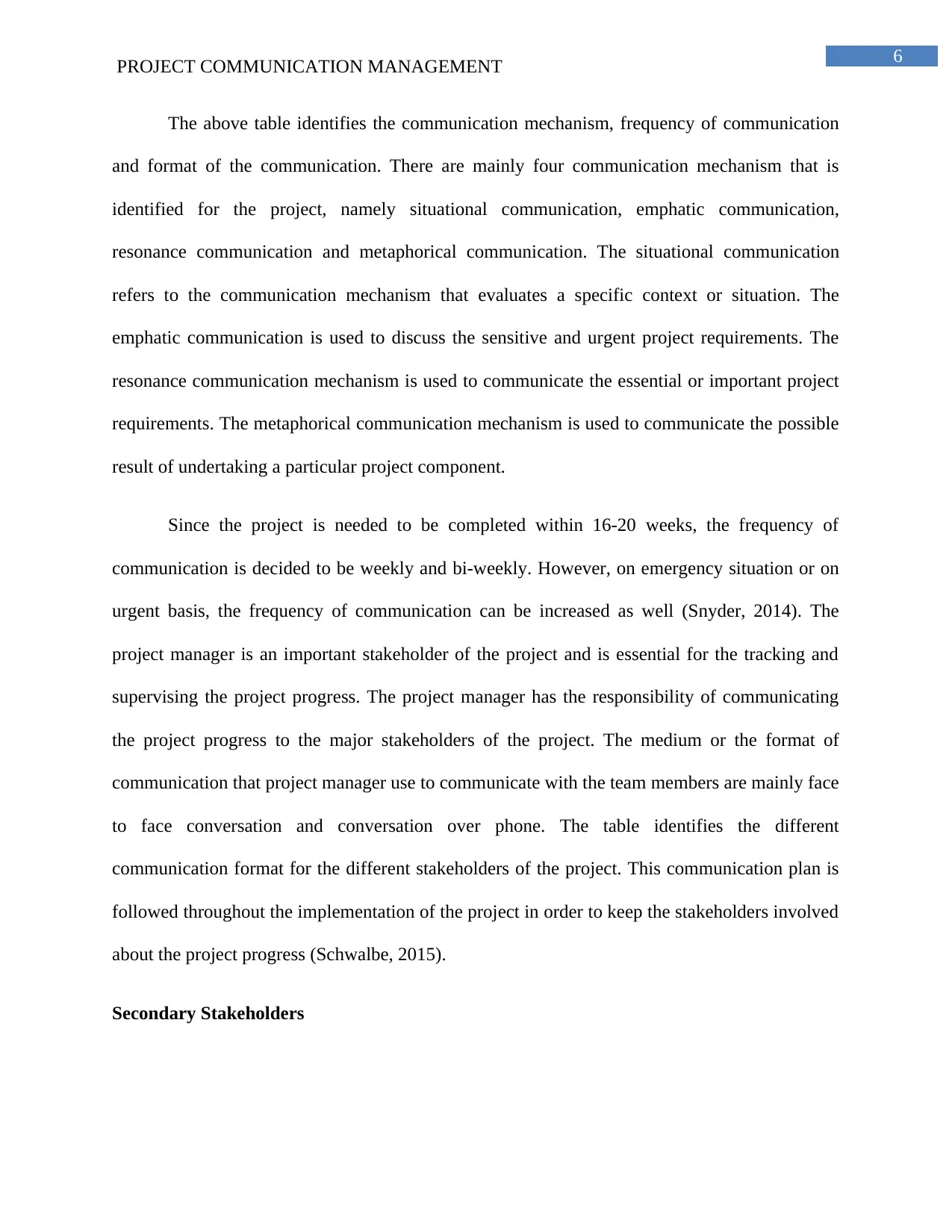
6
PROJECT COMMUNICATION MANAGEMENT
The above table identifies the communication mechanism, frequency of communication
and format of the communication. There are mainly four communication mechanism that is
identified for the project, namely situational communication, emphatic communication,
resonance communication and metaphorical communication. The situational communication
refers to the communication mechanism that evaluates a specific context or situation. The
emphatic communication is used to discuss the sensitive and urgent project requirements. The
resonance communication mechanism is used to communicate the essential or important project
requirements. The metaphorical communication mechanism is used to communicate the possible
result of undertaking a particular project component.
Since the project is needed to be completed within 16-20 weeks, the frequency of
communication is decided to be weekly and bi-weekly. However, on emergency situation or on
urgent basis, the frequency of communication can be increased as well (Snyder, 2014). The
project manager is an important stakeholder of the project and is essential for the tracking and
supervising the project progress. The project manager has the responsibility of communicating
the project progress to the major stakeholders of the project. The medium or the format of
communication that project manager use to communicate with the team members are mainly face
to face conversation and conversation over phone. The table identifies the different
communication format for the different stakeholders of the project. This communication plan is
followed throughout the implementation of the project in order to keep the stakeholders involved
about the project progress (Schwalbe, 2015).
Secondary Stakeholders
PROJECT COMMUNICATION MANAGEMENT
The above table identifies the communication mechanism, frequency of communication
and format of the communication. There are mainly four communication mechanism that is
identified for the project, namely situational communication, emphatic communication,
resonance communication and metaphorical communication. The situational communication
refers to the communication mechanism that evaluates a specific context or situation. The
emphatic communication is used to discuss the sensitive and urgent project requirements. The
resonance communication mechanism is used to communicate the essential or important project
requirements. The metaphorical communication mechanism is used to communicate the possible
result of undertaking a particular project component.
Since the project is needed to be completed within 16-20 weeks, the frequency of
communication is decided to be weekly and bi-weekly. However, on emergency situation or on
urgent basis, the frequency of communication can be increased as well (Snyder, 2014). The
project manager is an important stakeholder of the project and is essential for the tracking and
supervising the project progress. The project manager has the responsibility of communicating
the project progress to the major stakeholders of the project. The medium or the format of
communication that project manager use to communicate with the team members are mainly face
to face conversation and conversation over phone. The table identifies the different
communication format for the different stakeholders of the project. This communication plan is
followed throughout the implementation of the project in order to keep the stakeholders involved
about the project progress (Schwalbe, 2015).
Secondary Stakeholders
Paraphrase This Document
Need a fresh take? Get an instant paraphrase of this document with our AI Paraphraser
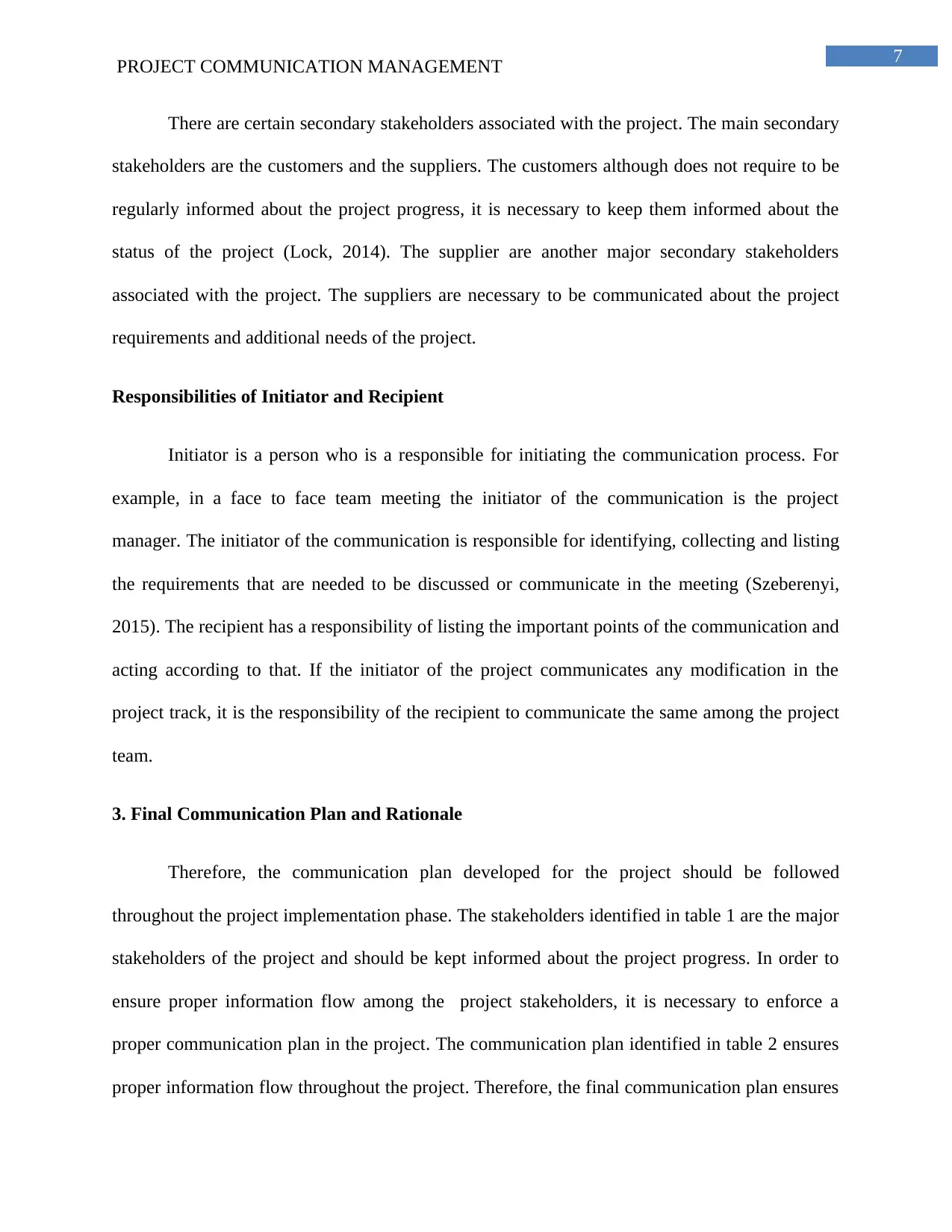
7
PROJECT COMMUNICATION MANAGEMENT
There are certain secondary stakeholders associated with the project. The main secondary
stakeholders are the customers and the suppliers. The customers although does not require to be
regularly informed about the project progress, it is necessary to keep them informed about the
status of the project (Lock, 2014). The supplier are another major secondary stakeholders
associated with the project. The suppliers are necessary to be communicated about the project
requirements and additional needs of the project.
Responsibilities of Initiator and Recipient
Initiator is a person who is a responsible for initiating the communication process. For
example, in a face to face team meeting the initiator of the communication is the project
manager. The initiator of the communication is responsible for identifying, collecting and listing
the requirements that are needed to be discussed or communicate in the meeting (Szeberenyi,
2015). The recipient has a responsibility of listing the important points of the communication and
acting according to that. If the initiator of the project communicates any modification in the
project track, it is the responsibility of the recipient to communicate the same among the project
team.
3. Final Communication Plan and Rationale
Therefore, the communication plan developed for the project should be followed
throughout the project implementation phase. The stakeholders identified in table 1 are the major
stakeholders of the project and should be kept informed about the project progress. In order to
ensure proper information flow among the project stakeholders, it is necessary to enforce a
proper communication plan in the project. The communication plan identified in table 2 ensures
proper information flow throughout the project. Therefore, the final communication plan ensures
PROJECT COMMUNICATION MANAGEMENT
There are certain secondary stakeholders associated with the project. The main secondary
stakeholders are the customers and the suppliers. The customers although does not require to be
regularly informed about the project progress, it is necessary to keep them informed about the
status of the project (Lock, 2014). The supplier are another major secondary stakeholders
associated with the project. The suppliers are necessary to be communicated about the project
requirements and additional needs of the project.
Responsibilities of Initiator and Recipient
Initiator is a person who is a responsible for initiating the communication process. For
example, in a face to face team meeting the initiator of the communication is the project
manager. The initiator of the communication is responsible for identifying, collecting and listing
the requirements that are needed to be discussed or communicate in the meeting (Szeberenyi,
2015). The recipient has a responsibility of listing the important points of the communication and
acting according to that. If the initiator of the project communicates any modification in the
project track, it is the responsibility of the recipient to communicate the same among the project
team.
3. Final Communication Plan and Rationale
Therefore, the communication plan developed for the project should be followed
throughout the project implementation phase. The stakeholders identified in table 1 are the major
stakeholders of the project and should be kept informed about the project progress. In order to
ensure proper information flow among the project stakeholders, it is necessary to enforce a
proper communication plan in the project. The communication plan identified in table 2 ensures
proper information flow throughout the project. Therefore, the final communication plan ensures

8
PROJECT COMMUNICATION MANAGEMENT
there will be atleast one meeting each week for communicating the project progress among the
team members (Heagney, 2016).
A communication plan is needed for managing the flow of vital information among the
project team members. The developed communication plan is expected simplify the
communication flow during the project execution.
Conclusion
Therefore, it can be concluded that a proper communication plan is needed to ensure
smooth information flow during the project execution. The report identifies the key stakeholders
of the project and develops a proper communication plan for communicating the vital
information associated with the project to the stakeholders. The report concludes the rationale
behind the preparation of a communication plan.
PROJECT COMMUNICATION MANAGEMENT
there will be atleast one meeting each week for communicating the project progress among the
team members (Heagney, 2016).
A communication plan is needed for managing the flow of vital information among the
project team members. The developed communication plan is expected simplify the
communication flow during the project execution.
Conclusion
Therefore, it can be concluded that a proper communication plan is needed to ensure
smooth information flow during the project execution. The report identifies the key stakeholders
of the project and develops a proper communication plan for communicating the vital
information associated with the project to the stakeholders. The report concludes the rationale
behind the preparation of a communication plan.
1 out of 9
Related Documents
Your All-in-One AI-Powered Toolkit for Academic Success.
+13062052269
info@desklib.com
Available 24*7 on WhatsApp / Email
![[object Object]](/_next/static/media/star-bottom.7253800d.svg)
Unlock your academic potential
© 2024 | Zucol Services PVT LTD | All rights reserved.





